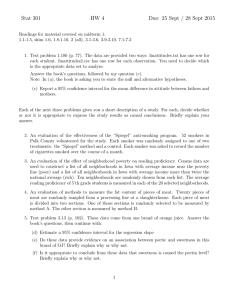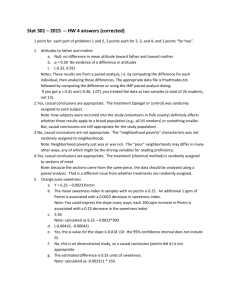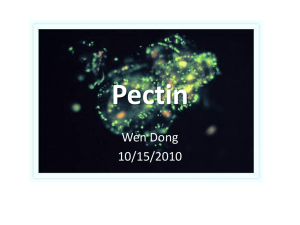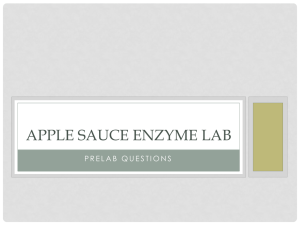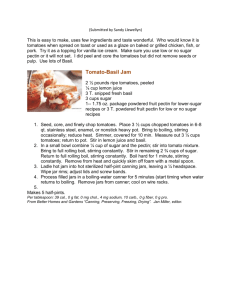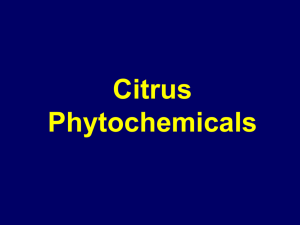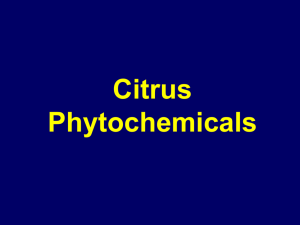“Study of Pectin from Peels of Magnifera Indica and Artocarpus Hetrophyllus” ,
advertisement
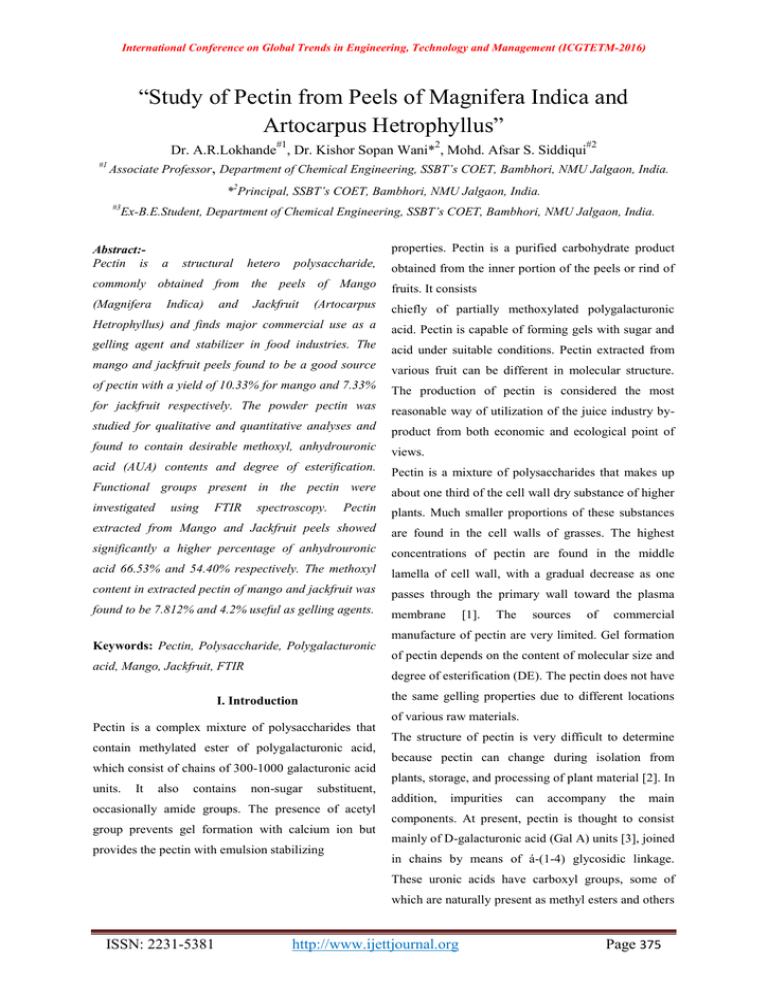
International Conference on Global Trends in Engineering, Technology and Management (ICGTETM-2016) “Study of Pectin from Peels of Magnifera Indica and Artocarpus Hetrophyllus” Dr. A.R.Lokhande#1, Dr. Kishor Sopan Wani*2, Mohd. Afsar S. Siddiqui#2 #1 Associate Professor, Department of Chemical Engineering, SSBT’s COET, Bambhori, NMU Jalgaon, India. *2Principal, SSBT’s COET, Bambhori, NMU Jalgaon, India. #3 Ex-B.E.Student, Department of Chemical Engineering, SSBT’s COET, Bambhori, NMU Jalgaon, India. Abstract:Pectin is properties. Pectin is a purified carbohydrate product a structural hetero polysaccharide, obtained from the inner portion of the peels or rind of commonly obtained from the peels of Mango fruits. It consists (Magnifera (Artocarpus chiefly of partially methoxylated polygalacturonic Hetrophyllus) and finds major commercial use as a acid. Pectin is capable of forming gels with sugar and gelling agent and stabilizer in food industries. The acid under suitable conditions. Pectin extracted from mango and jackfruit peels found to be a good source various fruit can be different in molecular structure. of pectin with a yield of 10.33% for mango and 7.33% The production of pectin is considered the most for jackfruit respectively. The powder pectin was reasonable way of utilization of the juice industry by- studied for qualitative and quantitative analyses and product from both economic and ecological point of found to contain desirable methoxyl, anhydrouronic views. acid (AUA) contents and degree of esterification. Pectin is a mixture of polysaccharides that makes up Functional groups present in the pectin were about one third of the cell wall dry substance of higher investigated Pectin plants. Much smaller proportions of these substances extracted from Mango and Jackfruit peels showed are found in the cell walls of grasses. The highest significantly a higher percentage of anhydrouronic concentrations of pectin are found in the middle acid 66.53% and 54.40% respectively. The methoxyl lamella of cell wall, with a gradual decrease as one content in extracted pectin of mango and jackfruit was passes through the primary wall toward the plasma found to be 7.812% and 4.2% useful as gelling agents. membrane Indica) using and FTIR Jackfruit spectroscopy. [1]. The sources of commercial manufacture of pectin are very limited. Gel formation Keywords: Pectin, Polysaccharide, Polygalacturonic acid, Mango, Jackfruit, FTIR of pectin depends on the content of molecular size and degree of esterification (DE). The pectin does not have the same gelling properties due to different locations I. Introduction of various raw materials. Pectin is a complex mixture of polysaccharides that contain methylated ester of polygalacturonic acid, which consist of chains of 300-1000 galacturonic acid units. It also contains non-sugar substituent, occasionally amide groups. The presence of acetyl group prevents gel formation with calcium ion but provides the pectin with emulsion stabilizing The structure of pectin is very difficult to determine because pectin can change during isolation from plants, storage, and processing of plant material [2]. In addition, impurities can accompany the main components. At present, pectin is thought to consist mainly of D-galacturonic acid (Gal A) units [3], joined in chains by means of á-(1-4) glycosidic linkage. These uronic acids have carboxyl groups, some of which are naturally present as methyl esters and others ISSN: 2231-5381 http://www.ijettjournal.org Page 375 International Conference on Global Trends in Engineering, Technology and Management (ICGTETM-2016) which are commercially treated with ammonia to purchase from local market of Jalgaon and peels were produce carboxyl amide groups. removed. All reagents and chemicals used were of analytical grade. For the extraction process, ethanol, Hydrochloric acid was purchased from SD Fine Chemicals Mumbai, India. III. Extraction Process: A. Preparation of AIS (Alcohol Insoluble Solid): The mango and jackfruit peels were washed with distilled water. Washed peels were cut into small pieces and were treated with ethyl alcohol at 60° C for Fig. 1 (a) a repeating segment of pectin molecule and functional groups: (b) carboxyl; (c) ester; (d) amide in pectin chain. Pectin contains from a few hundred to about 1000 saccharine units in a chain-like configuration; this corresponds to average molecular weights from about 50,000 to 150,000 Daltons. In addition to the galacturonan segments shown in Fig. 1, neutral sugars are also present. Rhamnose (Rha) is a minor component of the pectin backbone and introduces a kink into the straight chain (Fig. 2) and other neutral sugars such as arabinose, galactose and xylose occur in the side chains [4]. A chain of several hundred á-(14)-bonded Gal A units with a varied DE is a typical fragment. one hour. The mixture is kept for 15 hours at room temperature and filter through nylon cloth. The insoluble materials obtained are called as alcohol insoluble solid (AIS). The AIS were dried at 60° C in a vacuum oven, converted into powder form.[6] B. Extraction & Purification process of Pectin: AIS obtained from Mango/ Jackfruit was treated with distilled water in 1:25 ratio for 1 hour with continuous stirring at a temperature of 80OC. The mixture was filtered; the residue obtained was again treated with water at same condition for 20 minutes. The filtrate contains pectin, and coagulates it by using ethanol as a coagulating agent. In this process water used as extraction solvent, extracted pectin called as water extracted pectin (WEP). The pectin was coagulated with 96% acidic alcohol. The precipitated pectin was separated and washed with alcohol. Pectin was dried in a vacuum oven at 60° C (R1). The solid residue (R1) was treated with 0.5% HCl for 1 hour at 85° C with continuous stirring and the mixture was filtered. The pectin obtained through this Fig. 2 Schematic diagram showing how rhamnose (Rha) insertions process is called AEP.[7] cause kinking of galacturonic acid (GalA) chain; S = neutral sugars [5]. The schematic preparation of Alcohol Insoluble Solid II. Materials and Methods (AIS) and pectin extraction was presented in following flow diagram. A. Materials Two types of fresh fruits Mango (Magnifera Indica) and Jackfruits (Artocarpus Heterophyllus) were ISSN: 2231-5381 http://www.ijettjournal.org Page 376 International Conference on Global Trends in Engineering, Technology and Management (ICGTETM-2016) C. Process Flow Sheet: D. Process Flow Chart For Extraction Of Pectin From Mango And Jackfruit Peel Samples: Fig.3 Working Flow Sheet Fig.4 Experimental Flow Chart ISSN: 2231-5381 http://www.ijettjournal.org Page 377 International Conference on Global Trends in Engineering, Technology and Management (ICGTETM-2016) IV. METHODS OF ANALYSIS was titrated against 0.1N NaOH solution until colour of phenol red indicator changed to pink. [11], this was The dried pectin powder samples obtained from all two fruit peels were characterized to the following qualitative and quantitative tests. referred as Titration (A). D. Methoxyl Content: The methoxy content was determined by using A. Qualitative Tests neutralized solution obtained from equivalent weight 1) Colour: This was done by visual observation with naked eyes. 2 ) Solubility of Dry Pectin in Cold and Hot Water: determination, (Titration A) 25ml of 0.25N NaOH was Weighed 0.50 gm of dried pectin samples were taken and allow stand for 30min at room temperature in a in conical flasks which contains 10 ml of 95% ethanol stopper flask. After stipulated time of 30min 25ml of and further 50 ml of distilled water was added. The 0.25N HCl was added to this solution and titrated with mixture was shaken vigorously to form a suspension 0.1N NaOH solution until color of indicator changed which was then heated at 85-90°C for 15 min [8]. to pink. Methoxyl content is determined by the added to the neutralized solution with vigorous stirring 3) Solubility of Pectin Solution in Cold and Hot Alkali: following formula:[12] Weighed 1 ml of 0.1 N NaOH in conical flasks, 5ml of Methoxyl content = (ml of alkali*Normality of pectin solution was added and the second flask was alkali*3.1)/ (weight of sample) heated at 85- 90°C for 10 min [9]. E. Anhydrouronic Acid (AUA) Content: The AUA content was calculated using the values of V. QUANTITATIVE TEST equivalent weight and methoxyl content previously A. Moisture Content determined, according to following equation [11]: Five gram of pectin sample was weighed in to crucible. %AUA= [176/z]*100 The crucible was then transferred in to a vacuum oven, Where, 176 is the molecular weight of AUA and Z = at a temperature of 110OC + 10 O C for 1 to 1.5hr. (weight of sample (mg))/ (m eq of alkali for free acid After completion of stipulated time the crucible was + m eq of alkali for methoxyl) removed and cooled in desiccators and weighed. The F. Degree of Esterification (DE): process was repeated until constant weight was The DE of extracted pectin was calculated using obtained.[10] following equation, applying the data from methoxyl B. Ash Content and anhydrouronic acid content determinations [13]: Two gram of pectin sample was weighed in to crucible. DE % = [(176*MeO %) / (31*AUA %)]*10 The crucible was then kept in to muffle furnace which G. Yield (Percentage): was set at a temperature of 600c for 4hrs. After 4hr the Yield of pectin is based on the gram of peel sample crucible was removed and cooled in desiccators and weighed. The process is repeated until constant weight was obtained [10] taken, and is calculated by formula as given below; Ypec (%) = 100 (P/ Bi) %Ash content= [(weight of sample after heating)/ Where Ypec (%) is the extracted pectin yield in (weight of sample before heating)]*100 percent (%), P is the amount of dry pectin in g and Bi C. Equivalent Weight is the initial amount of fruit peel powder in gram.[14] Weighed 1.0g of pectin sample in a conical flask and 5ml of ethanol with 1gm of NaCl was added into it followed by 100 ml of distilled water. The solution ISSN: 2231-5381 http://www.ijettjournal.org Page 378 International Conference on Global Trends in Engineering, Technology and Management (ICGTETM-2016) Table no. 1 Qualitative test for mango and jackfruit peel pectin VI. STRUCTURAL ANALYSIS sample The FTIR spectra was use to obtained information on Parameter Mango Jackfruit Color brown Dark brown Solubility in cold water insoluble Insoluble Solubility in hot water soluble Soluble Solubility of pectin suspension in cold alkali Yellow precipitate form Yellow precipitate form Solubility of pectin suspension in hot alkali Suspension dissolved and white precipitate forms Suspension dissolved and white precipitate forms chemical structure FTIR data were obtained using Agilent Technology Model wavelength ranging from 650 – 4,000 cm ¹. A. FTIR Spectra of Mango Pectin: Fig.5 FTIR spectra of mango pectin B. FTIR Spectra of Jackfruit Pectin: Table No. 2 Characteristics properties of pectin from Mango and Jackfruit peels Characteristics Mango Peels Jackfruit peels Moisture content 8.875% 10.30% Ash content 5.864% 7.40% Fig.6 FTIR spectra of jackfruit pectin Equivalent 793.6gm/mol 576gm/mol The Fourier Transform Infrared (FTIR) spectra show the Weight functional groups and provide structural information about the extraction pectin. The major Methoxyl 7.812% 4.20% functional group in pectin is usually in the region between 1000 and 2000 cm ¹ of the FTIR spectra. The content carbonyl bands at 1,630 – 1,650 and 1,740 – 1,760 Anhydrouronic 66.53% 54.40% acid Degree of cm ¹indicate the free and esterified carboxyl groups respectively. The increase in DE values will also 66.66% 43.83% esterification increase intensities and band area of esterified carboxyl groups. This could be use to compare the different types of pectin. No measure structural Yield 10.33% 7.43% difference was observed in the FTIR spectra of the pectin sample extracted from mango, jackfruit while comparing with standard pectin. ISSN: 2231-5381 http://www.ijettjournal.org Page 379 International Conference on Global Trends in Engineering, Technology and Management (ICGTETM-2016) environmental point of view. These results VII. RESULT AND DISCUSSION demonstrate the successful extraction of pectin having The pectin is very hydroscopic. The moisture content many more industrial uses. The analysed properties of of mango and jackfruit pectin in this work is reported extracted pectin are similar to those of commercial as 8.875% and 10.30% respectively. The ash content pectin as reported in the literature. The mango and of the extracted pectin in this work is found to be low jackfruit peels found to be a good source of pectin as 5.86% for mango and 7.4% for jackfruit [15,16]. with a yield of 10.33% for mango and 7.33% for The yield of pectin from mango and jackfruit peels jackfruit respectively, on dry weight basis when powder was 10.33 % and 7.43%, the result observed extracted using the dried powder of pectin. The that it was nearer to literature reported by Z.U. present work has confirmed the extract of pectin from Rehman et, al [15]. Presence of anhydrouronic acid in mango and jackfruit peels and their characterization extracted from mango and jackfruit pectin was found with the pectin powders. These two fruit peels to be 66.53% and 54.40% respectively, this indicates especially exhibiting desirable properties for the the purity of pectin [16]. industrial applications. The methoxyl contain in pectin indicates the gel formation capacity. The methoxyl content in mango REFERENCES and jackfruit extracted pectin was found to be 7.812% [1] Kertesz, Z.I. (1951). The pectic substances (New York: and 4.2%, comparable to the result reported in Interscience) literature (8.33 ±0.11%). The variations of reported [2] Novesl’skaya, I.L. (2000). Trends in the science and applications of pectin, Chemistry of natural compounds, 36, pp. 1- results are due to varieties of mango and jackfruit 10. peels used for processes. Degree of esterification [3] Mukhidinov, Z.K., (2000). Isolation and characterization of a depends on two major groups: (i) Higher Ester pectin pectin. Homo and ramnogalacturonan. Talanta, 53, pp. 171-176. with higher DE (50% - 70%) and (ii) Lower Ester [4] Okenfull, D.G. (1991). The chemistry of high methoxyl pectin. In the chemistry and technology of pectin, ed. R.H. Walter. (New pectin with lower DE (20% - 40%). Degree of York: Academic press) esterification for mango and jackfruit pectin was [5] [8] Okenfull, D.G. (1991). The chemistry of high methoxyl reported as 66.66% and 43.83% respectively. The pectin. In the chemistry and technology of pectin, ed. R.H. Walter. reported value of DE for mango peels pectin (66.66%) (New York: Academic press) [9] Sriamornsak, P. (1998). Investigation of pectin as a carrier for is similar to value reported in literature (68.82 ±0.5%) [15, 16] oral delivery of protein using calcium pectinate gel beads. International generals of pharmaceutics, 169, pp. 213-220. VIII. CONCLUSION [10] Association of Official Analytical Chemists (AOAC).( 2000), To avoid the environmental problem, present work Vitamins and other nutrients. In Hurwitz, W. (Ed). Official Methods of Analysis of Association of Analytical Chemists International, p. reveled that, peels of mango and jackfruit are the good 12-20. Maryland USA: AOAC International Publications. raw materials for extraction of pectin, which was Sriamornsak, P. (1998). Investigation of pectin as a carrier for oral treated as a nuisance for environment as a waste. It delivery of protein using calcium pectinate gel beads. International was observed from the process flow diagram figure 1 generals of pharmaceutics, 169, pp. 213-220. [6] Yapo, B. M. and Koffi, K. L. (2006). Yellow passion fruit Rind- and 2 that, the peel source shows higher yield of A potential source of low-methoxyl pectin. Journal of Agricultural pectin with a yield of 10.33% for Mango and 7.33% and Food Chemistry 54 (7): 2738-2744. for Jackfruit respectively, on dry weight basis. The [7] Kratchanova, M., Pavlova, E. and Panchev, I.( 2004). The effect dried powder of pectin is most suitable for food and of microwave heating of fresh orange peels on the fruit tissue and quality of extracted pectin. Carbohydrate Polymers 56 (2): 181-185. pharmaceutical industries from an economic and ISSN: 2231-5381 http://www.ijettjournal.org Page 380 International Conference on Global Trends in Engineering, Technology and Management (ICGTETM-2016) [11] Owens, H.S., R.M. Mc Cready, A.D. Shepherd, S.H. Schultz, [15]Rehman, E.L. Pippen, H.A. Swenson, J.C. Miers, R.F. Erlandsen and W.D. W.H.,(2004),Jour. Chem Society Pak, Utilization of Mango Peel as Maclay, (1952), a source of Pectin. Vol.26 No.1 PP 73-76. methods used at Western Regional Research Z.U.,Salariya, A.M.,Habib, F. and Shah, Laboratory for Extraction and Analysis of Pectic Materials, AIC- [16] Koh, P.C., Leong, C.M.,and Naranizam, M.A.,(2014), 340, Western Regional Research Laboratory, Albany, California. Microwave assisted extraction of pectin from jackfruit rinds using [12] Norziah, M.H., E.O. Fang and A.A. Karim, (2000), Extraction different power levels, International Food Researcg Journal; and Characterization of Pectin from Pomelo Fruit Peels. In P.A. 21(5):2091-2097. Williams (Ed.), Gums and Stabilisers for the Food Industry, Cambridge, UK. The Royal Society of Chemistry, 10: 26-36. [13] Schultz, T., (1976). Methods in Carbohydrate Chemistry. In T. Schultz, Methods in CarbohydrateChemistry, New York: Academic Press, pp: 189. [14] Li, D., Jia, X., Wei, Z. and Liu, Z. (2012). Box-behnken experimental design for investigation of microwave-assisted extracted sugar beet pulp pectin. Carbohydrate Polymers 88 (1): 342-346. ISSN: 2231-5381 http://www.ijettjournal.org Page 381
